











The Medulla Nebula is a supernova remnant in Cassiopeia. It is also refered to as "Garlic Head Nebula" or "Popped Balloon Nebula", catalogue numbers are Abell 85, LBN 576 and CTB 1. It was discovered in 1955 by American astronomer George Ogden Abell during a survey of the "Palomar Observatory Sky Survey" (POSS) and is associated with a radio pulsar which originates from the same supernova, which exploded about 10.000 years ago. |
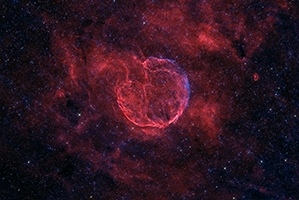
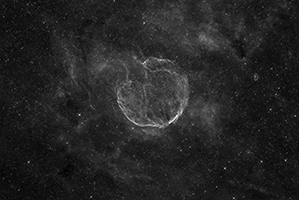
|
I took a deep image the emission nebula Sharpless 92, which is located in Vulpecula, but close to the southern edge of Cygnus, about 4 degrees east of Albireo, β Cygni. I do not find many deep photographs of this nebula and its surroundings. There is a variety of nebulae here, both dark and light. There is also quite some structure which I captured in Sh2-92. |
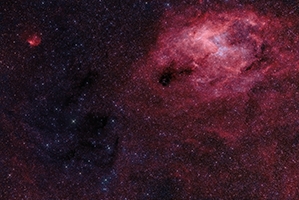
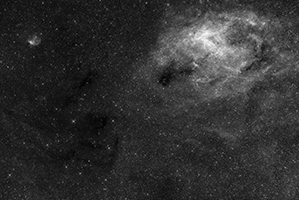
|
M94, the Cat's Eye Galaxy, is a barred spiral galaxy located in the constellation Canes Venatici. M94 is notable for its bright core, its distinct central bar structure, and well-defined spiral arms, which are rich in star formation regions, giving it a visually striking appearance. |
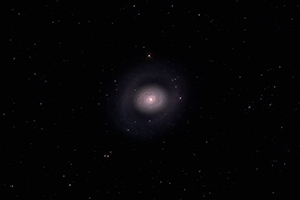
|
The LDN 998 Region in Cygnus, located about 5 degrees north of the North American Nebula, contains nicely structured dark dust clouds, blue reflection nebulae, and red emission nebulae There is also a young T Tauri star with a small dust disk surrounding it, and a Herbig-Haro object. |

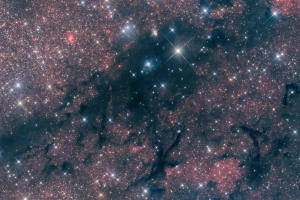
|
NGC 281, the Pacman nebula is an emission nebula in Cassiopeia well-known for its resemblance to the video game character. Embedded in NGC 281 is the open star cluster IC 1590, whose stars are scattered around the center of the nebula and some of which stand out due to their X-rays. The stars of this cluster are the ionizing source of the nebula. |


|
Van den Bergh 130 is a small reflection nebula in Cygnus located in an interesting field full of different nebulae immediately southwest of the 2nd magnitude star γ Cygni (Sadr). The field also contains emission nebulae like Sharpless 108, dark nebulae like Barnard 343 and Barnard 344 and other reflection nebulae like GM 2-39. |
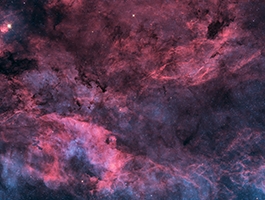
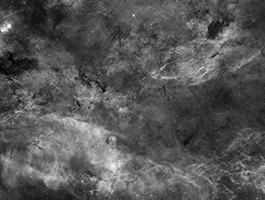
|
An image of the Heart Nebula IC 1805, which is an emission nebula located in the constellation Cassiopeia, five degrees north of the famous Double Cluster in Perseus. The nebula is composed of glowing gas and dust, illuminated by young, hot stars, many of which are members of the star cluster Melotte 15, which is nestled within the nebula. Follow the link to see a 100% enlargement of the nebula's center and of the area around the Planetary Nebula PN G135.6+01.0 (WeBo 1), which is located at the eastern edge of IC 1805. |


|
Another famous supernova remnant (SNR) is IC 443 the Jellyfish Nebula in the constellation Gemini. I have taken a wide-field image of this SNR which is framed by the 3rd magnitude stars μ and η Geminorum. The image also contains the older SNR G189.6+3.3, the emission nebula Sh2-249 and the mixed emission/reflection nebula IC 444. |
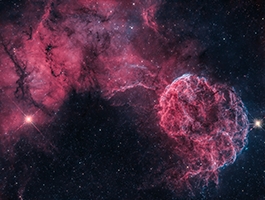
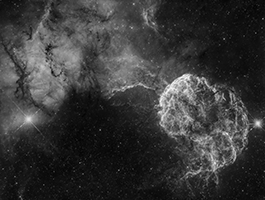
|
An image of NGC 6960/74/79, the Western Veil and Pickering's Triangle in Cygnus. The Veil Nebula is the remnant of massive star, which exploded 10,000-20,000 years ago in a supernova. |
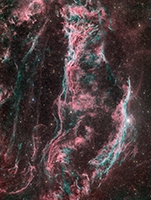
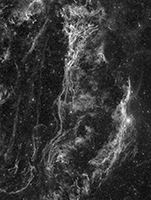
|
An image of NGC 6888, the Crescent Nebula and its western surroundings in Cygnus. The Crescent Nebula was formed by fast stellar wind from the Wolf-Rayet star WR 136 colliding with slower moving stellar wind from an earlier stage of the same star. The background is dominated by red-colored HII nebulae which cover large parts of the constellation. |
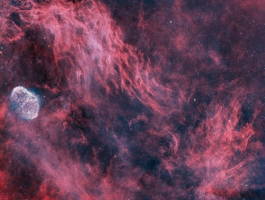
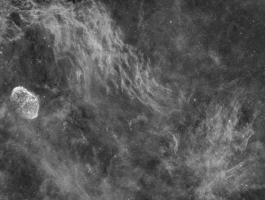
|
New processing of the image of Sharpless 126. The broadband images were taken during my stay at the Großglockner-Hochalpenstraße in September 2020, the narrowband images (Hα and [OIII]) in Vienna. This is an interesting region in southern Lacerta, where a blue-green molecular cloud (LBN 437) overlaps with a large red emission nebula (Sh2-126), forming a "stellar funnel" containing a symmetric reflection nebula. The total exposure time is 30 hours: 9 hours under dark mountain skies for broadband color, 10 hours for narrowband Hα and 11 hours for narrowband [OIII]. All images were taken with the 125 mm Wright-Newtonian. The color images taken in the mountains have a much better depth than the narrowband images taken in Vienna. Processing the Hα and especially the [OIII] images was difficult, mainly because of the uneven gradients in the city sky. |
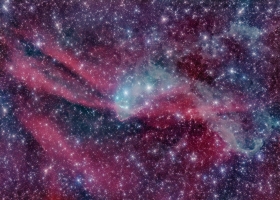
|
Astronomy in the City: In the late summer of 2021, I took exposures of the Tulip Nebula (Sh2-101) in Cygnus from my backyard in Vienna, Austria using Hα and [OIII] narrow-band filters with good results. I mixed the two monochrome images for a near-natural color image. The Hα image also turned out surprisingly well for a light-polluted city sky. I used the 9.5" Newtonian reflector and a ZWO ASI1600MM Pro monochrome camera for the exposures. I have added starless version of both images as mouse-overs. |
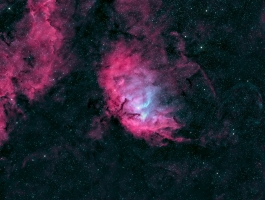
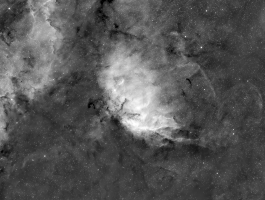
|
A telelens photograph of IC 5146 - Cocoon Nebula and Surrounding Area, which is located in a dense part of the Milky Way in Northern Cygnus. It can be found at the eastern end of the elongated dark cloud Barnard 168 and is part of an extended molecular cloud. An annotated version of the image is overlaid on mouse-over or touch. This photo was taken parallel to the telescope image below. The Samyang 135mm lens was used mounted piggy-back on the main telescope. |

|
During my August 2023 stay in the Austrian Alps I had the fortune to enjoy three clear nights in a row, two of which I used to get a deep image of IC 5146, the Cocoon Nebula and the prominent large dark nebula Barnard 168 running towards it from the northwest. For this exposure series, I used my I used my 3-telescope "Triple Setup" and 3 cameras to capture color, Hα and [OIII] images at the same time. |
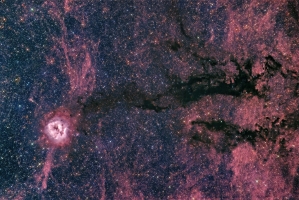
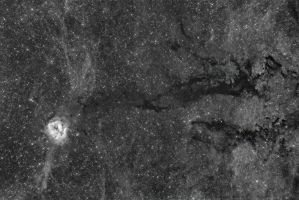
|
During the 2023 Perseid meteor shower, I have only been able to go out to a dark observation site during the night of August 14-15, when the meteor activity was on its decline. However, I got lucky and captured a moderately bright Perseid streaking down along the Summer Milky Way, changing color and emitting a small flash towards the end of its trail. The camera used was my trusty old Nikon D7000, the exposure time 20 seconds, and the focal length 18mm at f/3.5. The camera was mounted on a fixed tripod. I was actually taking a timelapse exposure series, and this is one of the images. |

|
I have updated the Telescopes and Equipment page and included pictures of all telescopes and most cameras which I currently use. This page is, of course, subject to frequent changes, although I tend to keep my trusty equipment for a long time. I generally try to master all of my equipment and reach the best performance it can offer before moving on, and this takes years. |

|
Important info: